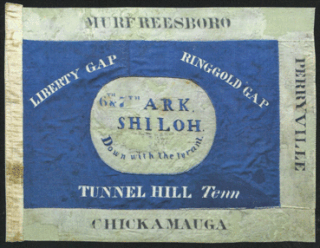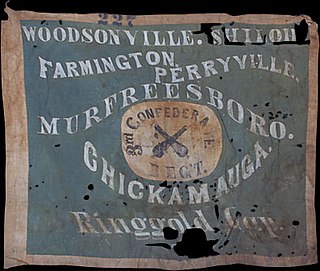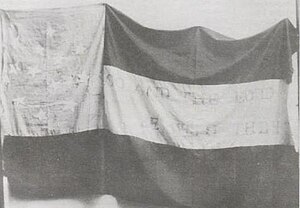1st Arkansas Mounted Rifles (1861–1865) was a Confederate States Army cavalry regiment during the American Civil War. The unit was formed as a mounted infantry regiment, but was dismounted in the spring of 1862 and remained dismounted for the remainder of the war. The unit participated in the earliest battles in the western theater at Wilson's Creek and surrendered with the remnants of the Army of Tennessee in North Carolina in April 1865.

The 4th Arkansas Infantry was a Confederate States Army infantry regiment from the state of Arkansas during the American Civil War. The 4th Arkansas served throughout the war in the western theater, seeing action in the Kentucky, Tennessee and Georgia campaigns. Following its depletion in numbers the regiment was consolidated several times with other Arkansas regiments, finally merging in 1865 into the 1st Arkansas Consolidated Mounted Rifles. Another Arkansas unit also had the designation 4th Arkansas, the 4th Regiment, Arkansas State Troops which participated in the Battle of Wilson's Creek, but was never transferred to Confederate Service. There is no connection between the two units.

The 1st Arkansas Infantry (1861–1865) was a Confederate Army infantry regiment during the American Civil War. The regiment was raised in April 1861 by Colonel Thompson B. Flournoy. It moved first to Virginia, but transferred back to Tennessee and served the rest of the war in the western theater, seeing action in the Kentucky, Tennessee and Georgia campaigns. Following its depletion in numbers, the regiment was consolidated several times with other Arkansas regiments, finally merging in 1865 into the 1st Arkansas Consolidated Infantry Regiment. There were three regiments known as "1st Arkansas" during the war. The second unit with the designation of "1st Arkansas" was the 1st Infantry, Arkansas State Troops, which was mustered into Confederate service at Pitman's Ferry, Arkansas, on 23 July 1861, under the command of Colonel Patrick Cleburne; this unit was eventually redesignated as the 15th Arkansas Volunteer Infantry. The third unit bearing the title "1st Arkansas" was the 1st Arkansas Volunteer Infantry, which served with the Union Army.

The 5th Arkansas Infantry, also called the Fighting Fifth (1861–1865) was a Confederate Army infantry regiment organized in Arkansas to serve for the Confederate States of America during the American Civil War. It served throughout the war in the western theater, seeing action in the Kentucky, Tennessee and Georgia campaigns. Following its depletion in numbers the regiment was consolidated several times with other Arkansas regiments, finally merging in 1865 into the 1st Arkansas Consolidated Infantry Regiment. Another Arkansas unit also had the designation 5th Arkansas, the 5th Regiment, Arkansas State Troops which participated in the Battle of Wilson's Creek, but was never transferred to Confederate Service. There is no connection between the two units.
The 2nd Arkansas Infantry was an army regiment of the Confederate Army during the American Civil War. The regiment was raised in May 1861 under Colonel Thomas C. Hindman. It served throughout the war in the western theater, in the Confederate Army of Tennessee, seeing action in the Kentucky, Tennessee and Georgia campaigns. Following its depletion in numbers, the regiment was consolidated several times with other Arkansas regiments, finally merging in 1865 into the 1st Arkansas Consolidated Infantry Regiment. The regiment has no connection with the 2nd Regiment, Arkansas State Troops, which participated in the Battle of Wilson's Creek, and is also separate from the 2nd Arkansas Consolidated Infantry Regiment, which was formed in 1864 from remnants of regiments surrendered at Vicksburg and Port Hudson.
The 13th Arkansas Infantry (1861–1865) was a Confederate Army infantry regiment during the American Civil War. Organized mainly from companies, including several prewar volunteer militia companies, raised in northeastern Arkansas, the regiment was among the first transferred to Confederate Service, and spent virtually the entire war serving in Confederate forces east of the Mississippi River. After the unit sustained heavy casualties during the Battle of Murfreesboro, the unit spent most of the rest of the war field consolidated with the 13th Arkansas Infantry Regiment, to form the 5th/13th Arkansas Infantry Regiment.

The 7th Arkansas Volunteer Infantry (1861−1865) was a Confederate Army infantry regiment during the American Civil War. Organized mainly from companies, including several prewar volunteer militia companies, raised in northeastern Arkansas, the regiment was among the first transferred to Confederate service, and spent virtually the entire war serving east of the Mississippi River. After the unit sustained heavy casualties in the Battle of Shiloh and the Kentucky Campaign, the unit spent most of the rest of the war field consolidated with the 6th Arkansas Infantry Regiment to form the 6th/7th Arkansas Infantry Regiment.

8th Arkansas Infantry Regiment was an infantry formation in the Confederate States Army during the American Civil War. It served throughout the war in the western theater, seeing action in the Kentucky, Tennessee and Georgia campaigns. Following its depletion in numbers the regiment was consolidated several times with other Arkansas regiments, finally merging in 1865 into the 1st Arkansas Consolidated Infantry Regiment.

The 25th Arkansas Infantry was an infantry regiment of the Confederate States Army during the American Civil War. The unit was originally organized as Turnbull's 11th Arkansas Infantry Battalion. Upon being increased by the required number of companies the battalion was organized as the 30th Arkansas Infantry Regiment but was later redesignated as the 25th Arkansas Infantry. There were two regiments officially designated as the 30th Arkansas Infantry. The other "30th Arkansas" served west of the Mississippi River, in the Department of the Trans-Mississippi and was also known as 5th Trans-Mississippi Regiment or the 39th Arkansas or Rogan's Arkansas Cavalry during Price's 1864 Missouri Expedition.
The 15th Arkansas Infantry Regiment or Josey's Arkansas Infantry Regiment was an infantry formation in the Confederate States Army during the American Civil War. The regiment was organized in May 1861 under the command of Colonel Patrick Cleburne. It served throughout the war in the western theater, seeing action in the Kentucky, Tennessee, and Georgia campaigns. Following its depletion in numbers the regiment was consolidated several times with other Arkansas regiments, finally merging in 1865 into the 1st Arkansas Consolidated Infantry Regiment. There were two other regiments which also received the designation of "15th Arkansas". The 21st (McRae's) Arkansas Infantry was redesignated 15th Arkansas in February 1863, but to avoid confusion, was normally referred to as the "Northwest regiment". This second "15th Arkansas" was surrendered at Vicksburg in July 1863. A third regiment, under command of Colonels Gee and later Johnson, also received the designation 15th Arkansas Infantry. This last regiment surrendered at Port Hudson, Louisiana, in July 1863.

The 18th Arkansas Infantry (Marmaduke's) (1861–1865) was a Confederate Army infantry regiment during the American Civil War. The unit was also briefly identified as the 1st Arkansas Infantry Battalion. The unit was most often referred to as the 3rd Confederate Infantry Regiment. The designation "Confederate Infantry Regiment" was intended to convey the difference between Provisional Confederate Army units and Regular Confederate Army Units, with Provisional units being those regiments who received a state designation such as "XX Arkansas Infantry Regiment". In practice, the designation was most often utilized when Regiments were assembled utilizing companies from more than one Confederate state. The "3rd Confederate Infantry Regiment" is occasionally misidentified as the 3rd Arkansas Infantry Regiment commanded by Colonel Van H. Manning.

The 4th Battalion, Arkansas Infantry was an infantry Battalion of the Confederate States Army during the American Civil War. The battalion served in the same brigade and was later consolidated with the 4th Arkansas Infantry Regiment, but units began as completely separate and unrelated organizations.

The 9th Arkansas Infantry Regiment was a regiment of the Confederate States Army during the American Civil War. It served in the Western Theater, seeing action in the Vicksburg, Tennessee and Georgia campaigns. Due to attrition; the 9th Arkansas was consolidated several times with other Arkansas regiments, finally merging in 1865 into the 1st Arkansas Consolidated Mounted Rifles.
The 18th Arkansas Infantry Regiment or Carroll's Arkansas Infantry Regiment was an infantry formation of the Confederate States Army during the American Civil War. The regiment was raised in April 1862 under the command of Colonel D. W. Carroll. It served east of the Mississippi in several actions before being surrendered at Port Hudson in July 1863. Reorganized, the regiment was finally merged with several other Arkansas units to form the 2d Consolidated Arkansas Infantry. There was another regiment designated as the 18th Arkansas. When Lieutenant-Colonel J. S. Marmaduke's 1st Arkansas Infantry Battalion was increased to a regiment, it was briefly designated as the 18th Arkansas Infantry. Marmaduke's regiment was subsequently redesignated as the 3d Confederate Infantry.
The 19th Arkansas Infantry Regiment or Dockery's Arkansas Infantry Regiment was an infantry formation of the Confederate States Army during the American Civil War. There were two other regiments which were designated as the 19th Arkansas. Dawson's 19th Arkansas Infantry was organized at Nashville, Arkansas, on November 21, 1861. Hardy's Arkansas Infantry, which is also occasionally referred to as the 19th Arkansas was organized in 1863 from those parts of Dawson's 19th Infantry Regiment, the 24th Arkansas Infantry Regiment and Crawford's Arkansas Infantry Battalion, which escaped capture at the Battle of Arkansas Post.

The 23rd Arkansas Infantry (1862–1865) was a Confederate Army infantry regiment during the American Civil War. In the summer of 1864, the unit was reorganized as a mounted infantry regiment in preparation for Price's Missouri Expedition and officially redesignated as the 42nd Arkansas Infantry (Mounted). The unit was often referred to as Lyle's Arkansas Cavalry in report from Price's Missouri Expedition. Due to its mounted status, the unit is also occasionally referred to as the 23rd Arkansas Cavalry Regiment.
The 21st Arkansas Infantry (1862–1865) was a Confederate Army infantry regiment during the American Civil War. The unit was organized from the consolidation of two understrength Arkansas units in May 1862. The unit participated in the Iuka-Corinth Campaign before becoming part of the garrison of Vicksburg Mississippi. After the capitulation of Confederate forces at Vicksburg, the 21st was paroled and exchanged back to Arkansas where it was combined with the remnants of several there Arkansas regiments to become the 1st Arkansas Consolidated Infantry Regiment (Trans-Mississippi). Another Arkansas Confederate infantry regiment, commanded by Colonel Dandridge McRae was also labeled the "21st Arkansas". To avoid confusion between two 21st Arkansas Regiments, McRae's regiment was later redesignated as the 15th (Northwest) Arkansas Infantry Regiment.
The 2nd Arkansas Mounted Rifles (1861–1865) was a Confederate Army infantry regiment that served during the American Civil War. Raised in 1861, the regiment consisted of nine companies, which were drawn from various counties in Arkansas. Throughout the course of the war, the 2nd Arkansas Mounted Rifles fought in a number of battles, including those at Wilson's Creek and Pea Ridge, and participated in a number of campaigns such as Tullahoma, Atlanta and the Carolinas. The regiment's final battle came at Bentonville in March 1865 after which its remaining personnel were consolidated into the 1st Arkansas Consolidated Mounted Rifles.
The 38th Arkansas Infantry (1862–1865) was a Confederate Army infantry regiment during the American Civil War. The unit was often referred to as Shaver's Arkansas Infantry. The unit served in the Department of the Trans-Mississippi from its formation in the summer of 1862 until its surrender in May 1865.
The 1st Arkansas Cavalry Battalion (Stirman's) (1864–1865) was a Confederate Army cavalry battalion during the American Civil War. The unit was also known as Brooks 1st Arkansas Cavalry Battalion, Stirman's, 1st Arkansas Cavalry Battalion, Stirman's Sharpshooter Regiment, 1st Regiment Arkansas Sharpshooters, and finally simply as Stirman's Arkansas Cavalry Regiment.













